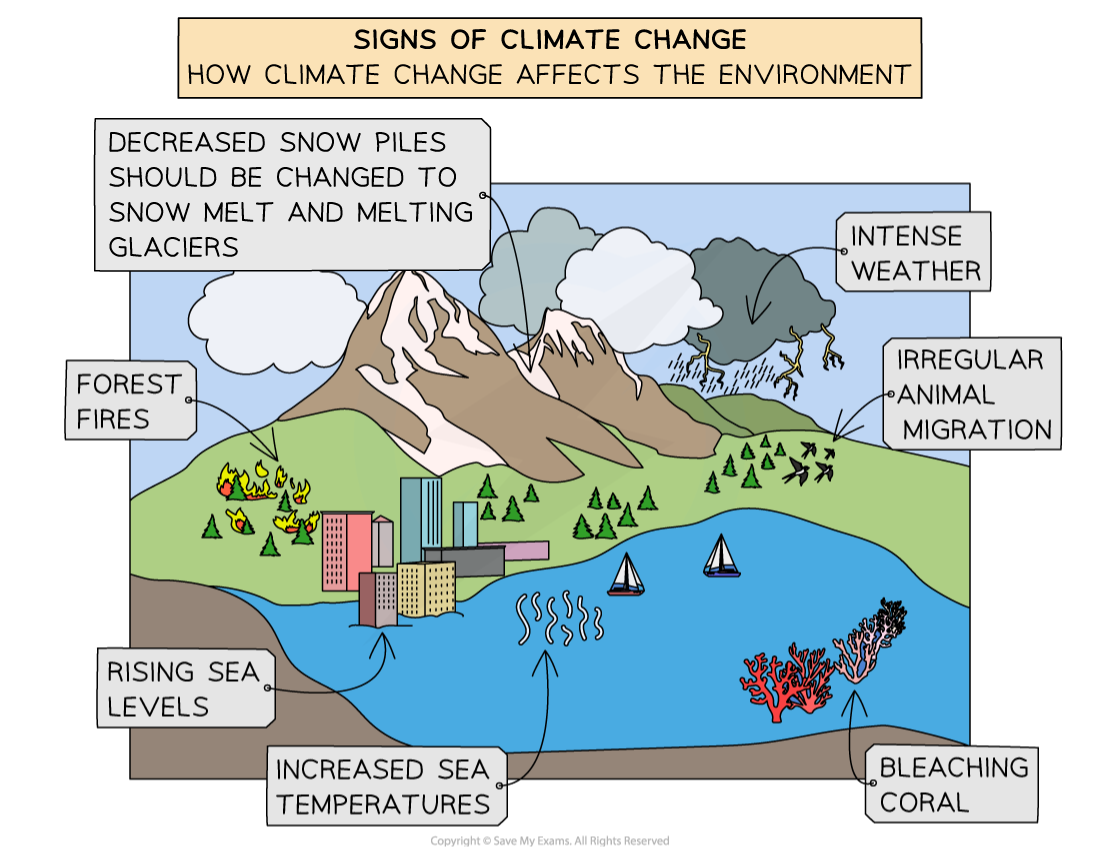Syllabus Edition
First teaching 2024
First exams 2026
Impacts of Climate Change on Ecosystems (DP IB Environmental Systems & Societies (ESS)): Revision Note
Impacts of climate change on ecosystems
Climate change:
Impacts ecosystems on various scales, from local to global
Affects the resilience of ecosystems
Leads to biome shifts

Local impacts
Coral bleaching
Cause:
Increased sea temperatures cause corals to expel the algae (zooxanthellae) living in their tissues
Without these algae, corals lose their colour (giving them a white appearance)
They also lose their main food source (the algae perform photosynthesis, producing organic compounds that the corals use as a primary energy source)
This leads to bleaching and eventually coral death
Effects:
Loss of biodiversity as fish and other marine species lose their habitat
Decline in fish populations in reef ecosystems
Example:
The Great Barrier Reef in Australia has experienced significant coral bleaching events
Desertification
Cause:
Prolonged droughts and higher temperatures
Unsustainable land practices like deforestation and overgrazing
Effects:
Loss of arable land and vegetation, leading to soil erosion
Reduced agricultural productivity
Displacement of communities
Example:
The Sahel region in Africa is facing severe desertification, affecting local livelihoods that rely on agriculture

Global impacts
Changes to ocean circulation
Cause:
Melting ice caps and glaciers increase the freshwater input into oceans
This disrupts normal currents and circulation patterns
Effects:
Altered weather patterns
Changes in marine and coastal ecosystems
Changes in fish migration and distribution affecting fisheries
Example:
Slowing down of Atlantic Meridional Overturning Circulation (AMOC), which includes the Gulf Stream
This is leading to colder winters in Europe and warmer temperatures in the Arctic
Sea-level rise
Cause:
Melting ice caps and glaciers
Thermal expansion of seawater due to higher temperatures
Effects:
Coastal flooding and erosion, impacting ecosystems like mangroves and salt marshes
Loss of habitats for species in these biodiverse ecosystems
Example:
The Maldives is at risk of becoming uninhabitable due to rising sea levels

Regional impacts on natural productivity
Increased productivity
Northern regions:
Warmer temperatures can extend the growing season and increase vegetation
Expansion of suitable areas for agriculture and forestry
For example, in parts of Canada and Russia, agriculture is expanding northward and growing seasons are longer due to warmer conditions
Decreased productivity
Tropical regions:
Higher temperatures and unpredictable rainfall can harm crops
For instance, shifting monsoon patterns in Southeast Asia are threatening rice yields
Factors affecting ecosystem resilience
Biodiversity
Climate change can reduce resilience by decreasing biodiversity
High biodiversity:
Increases resilience by providing a variety of species that can adapt to changes
For example, tropical rainforests have high biodiversity, helping them recover from disturbances
Low biodiversity:
Decreases resilience, making ecosystems more vulnerable
For example, monoculture farms are less resilient to pests and diseases
Impact of climate change:
Climate change can lead to habitat loss, altered food webs and extreme weather events
All of these can reduce biodiversity
For example, coral bleaching due to increased sea temperatures reduces the variety of species in coral reefs
This can reduce the resilience of coral reefs to other stressors, like ocean acidification or increased tropical storms
Habitat fragmentation
Climate change can also reduce resilience by causing habitat fragmentation
Connected habitats:
Enable species to migrate and adapt to changes
Fragmented habitats:
Isolate species and split populations, reducing their ability to adapt
Impact of climate change:
Rising temperatures and changing precipitation patterns can shift habitats, leading to fragmented landscapes
Climate change can fragment habitats in various ways:
Increased desertification: expanding deserts can divide ecosystems, making it harder for species to find resources and migrate
Increased rates of forest fires: more frequent and intense fires can break up forest ecosystems, isolating populations and reducing biodiversity
Melting polar ice caps: loss of ice habitats can fragment the habitats of polar species like polar bears and penguins, affecting their ability to hunt and reproduce
Species in mountainous regions might be forced to move to higher altitudes, creating isolated populations
These changes reduce the resilience of ecosystems by isolating species and limiting their ability to adapt to new conditions
Biome shifts
Climate change can result in biome shifts
This is where ecosystems change in location or type due to altered climatic conditions
Cause:
Changes in temperature, precipitation and extreme weather events
Effects:
Movement of biomes:
Biomes, such as forests, grasslands and tundra, may shift towards the poles or higher altitudes as species (including plants) shift ranges to find suitable climates
For example, in North America, temperate forests are moving northward, slowly replacing boreal forests
As species move to new areas or experience changes in their habitats, they may face new competition, predation, or disease
Transformation of existing biomes:
Current biomes may change in structure and composition
For example, the Arctic tundra is transforming into shrubland as warmer temperatures allow shrubs to grow
Loss of unique biomes:
Some biomes may disappear if conditions become unsuitable for the species that inhabit them
For example, alpine regions may lose their unique flora and fauna as temperatures rise and snow cover decreases
This can lead to declines in population numbers and even extinction in some cases
Examiner Tips and Tricks
Remember that climate change has mixed effects. While it poses significant challenges, it can also bring advantages, such as extended growing seasons and the ability to cultivate crops further north. Higher temperatures can make some crops more productive, benefiting certain regions and societies. Keep this balanced perspective in mind during your exams!

Unlock more, it's free!
Did this page help you?